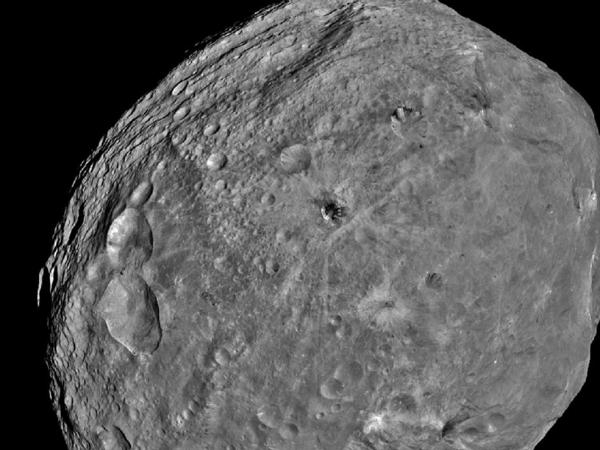Sending Back First Close-Up Views Of The Large Asteroid
NASA's Dawn spacecraft, the first ever to orbit an object in the
main asteroid belt, is spiraling towards its first of four
intensive science orbits. That initial orbit of the rocky world
Vesta begins Aug. 11, at an altitude of nearly 1,700 miles and will
provide in-depth analysis of the asteroid. Vesta is the brightest
object in the asteroid belt as seen from Earth and is thought to be
the source of a large number of meteorites that fall to Earth.

The Dawn team unveiled the first full-frame image of Vesta taken
on July 24. This image was taken at a distance of 3,200 miles.
Images from Dawn's framing camera, taken for navigation purposes
and as preparation for scientific observations, are revealing the
first surface details of the giant asteroid. These images go all
the way around Vesta, since the giant asteroid turns on its axis
once every five hours and 20 minutes. "Now that we are in orbit
around one of the last unexplored worlds in the inner solar system,
we can see that it's a unique and fascinating place," said Marc
Rayman, Dawn's chief engineer and mission manager at NASA's Jet
Propulsion Laboratory in Pasadena, Calif.
After traveling nearly four years and 1.7 billion miles, Dawn
has been captured by Vesta's gravity, and there currently are 1,800
miles between the asteroid and the spacecraft. The giant asteroid
and its new neighbor are approximately 114 million miles away from
Earth. "We have been calling Vesta the smallest terrestrial
planet," said Chris Russell, Dawn's principal investigator at the
UCLA. "The latest imagery provides much justification for our
expectations. They show that a variety of processes were once at
work on the surface of Vesta and provide extensive evidence for
Vesta's planetary aspirations."

Engineers still are working to determine the exact time that
Dawn entered Vesta's orbit, but the team has reported an
approximate orbit insertion time of 0047 EDT on July 16.
In addition to the framing camera, Dawn's instruments include
the gamma ray and neutron detector and the visible and infrared
mapping spectrometer. The gamma ray and neutron detector uses 21
sensors with a very wide field of view to measure the energy of
subatomic particles emitted by the elements in the upper yard
(meter) of the asteroid's surface. The visible and infrared mapping
spectrometer will measure the surface mineralogy of both Vesta and
Dawn's next target, the dwarf planet Ceres. The spectrometer is a
modification of a similar one flying on the European Space Agency's
Rosetta and Venus Express missions.
Dawn also will make another set of scientific measurements at
Vesta and Ceres using the spacecraft's radio transmitter in tandem
with sensitive antennas on Earth. Scientists will monitor signals
from Dawn and later Ceres to detect subtle variations in the
objects' gravity fields. These variations will provide clues about
the interior structure of these bodies by studying the mass
distributed in each gravity field. "The new observations of Vesta
are an inspirational reminder of the wonders unveiled through
ongoing exploration of our solar system," said Jim Green, planetary
division director at NASA Headquarters in Washington.
 ANN's Daily Aero-Term (12.13.25): Light Gun
ANN's Daily Aero-Term (12.13.25): Light Gun Aero-News: Quote of the Day (12.13.25)
Aero-News: Quote of the Day (12.13.25) NTSB Final Report: Gippsland GA-8
NTSB Final Report: Gippsland GA-8 Classic Aero-TV: Historically Unique -- Marlin Horst's Exquisite Fairchild 71
Classic Aero-TV: Historically Unique -- Marlin Horst's Exquisite Fairchild 71 Airborne 12.12.25: Global 8000, Korea Pilot Honors, AV-30 Update
Airborne 12.12.25: Global 8000, Korea Pilot Honors, AV-30 Update




